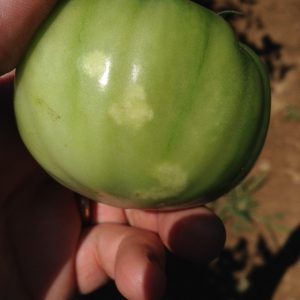Sweet Corn
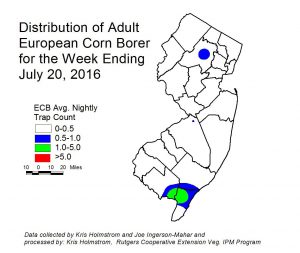 European corn borer (ECB) moth activity is now increasing in a few areas of the state (see ECB map) . Larval infestations have yet to appear. Be sure to begin monitoring plantings for ECB feeding while they are still in the whorl stage. Consider treating when the number of infested plants in a 50 plant sample exceeds 12%. Feeding in the whorl stage will appear as numerous small holes (called “shot-hole”) on leaves, with damage present on consecutively younger leaves. As plants progress to pre-tassel and beyond, droppings and larvae may be found in or on the emerging tassels. Any planting remaining at or above threshold as it proceeds to full tassel should be treated, as this is the last stage at which ECB larvae will be exposed and vulnerable to insecticidal sprays. Insecticides that are acceptable in organic production include the spinosyn based material Entrust (IRAC-5) and Dipel (IRAC-11a). The 10G formulation of Dipel is particularly useful when granules can be dropped or broadcast such that they get into the whorls of corn plants. Other effective insecticides include Coragen (IRAC 28), and the synthetic pyrethroids (IRAC 3). See the 2016 Commercial Vegetable Recommendations Guide for a more complete list of insecticides.
European corn borer (ECB) moth activity is now increasing in a few areas of the state (see ECB map) . Larval infestations have yet to appear. Be sure to begin monitoring plantings for ECB feeding while they are still in the whorl stage. Consider treating when the number of infested plants in a 50 plant sample exceeds 12%. Feeding in the whorl stage will appear as numerous small holes (called “shot-hole”) on leaves, with damage present on consecutively younger leaves. As plants progress to pre-tassel and beyond, droppings and larvae may be found in or on the emerging tassels. Any planting remaining at or above threshold as it proceeds to full tassel should be treated, as this is the last stage at which ECB larvae will be exposed and vulnerable to insecticidal sprays. Insecticides that are acceptable in organic production include the spinosyn based material Entrust (IRAC-5) and Dipel (IRAC-11a). The 10G formulation of Dipel is particularly useful when granules can be dropped or broadcast such that they get into the whorls of corn plants. Other effective insecticides include Coragen (IRAC 28), and the synthetic pyrethroids (IRAC 3). See the 2016 Commercial Vegetable Recommendations Guide for a more complete list of insecticides.
The highest nightly ECB catches for the previous week are as follows:
| Eldora 2 | Denville 1 |
| Allentown 1 | East Vineland 1 |
| Beckett 1 | Georgetown 1 |
| Centerton 1 | Lawrenceville 1 |
Infestations of fall armyworm (FAW) are becoming more common throughout the state. A number of infestations are above threshold, with small whorl stage plants most frequently impacted. Central counties are experiencing numerous infestations, particularly in coastal areas. FAW targets whorl corn of all sizes, and even very young plants should be checked weekly. FAW feeding is much more obvious than that of ECB larvae, with large ragged holes and conspicuous droppings found in the whorl. The larva is larger, and is general brown in color after it has molted twice (see photo at left). It is useful to note that FAW is less susceptible to the B.t. toxin found in older B.t. sweet corn lines. Therefore some FAW injury can still occur from seedling stage through ear development. FAW is also resistant to synthetic pyrethroid insecticides (IRAC 3), but can be effectively managed with insecticides such as Radiant/Entrust/Blackhawk (IRAC 5) or Coragen/Besiege (IRAC 28). Consider treating if damage from ECB and/or FAW reaches 12%.
 Corn earworm moth (CEW) captures in blacklights remain low. Highest activity remains across the southern third of NJ (see CEW blacklight map), but individuals have been captured as far north as Mercer County.
Corn earworm moth (CEW) captures in blacklights remain low. Highest activity remains across the southern third of NJ (see CEW blacklight map), but individuals have been captured as far north as Mercer County.
The highest nightly CEW catches for the previous week are as follows:
| Jones Island 1 | Cinnaminson 1 |
| Allentown 1 | East Vineland 1 |
| Beckett 1 | Eldora 1 |
| Centerton 1 | Pedricktown 1 |
In addition, a limited number of CEW pheromone traps have been deployed throughout the southern counties. These traps have captured low numbers of CEW moths over the past week. Highest activity from this network has been found from Gloucester through southern Burlington County (see CEW pheromone map). The broad color patterns of this map are a result of the few numbers of contributing trap sites. Green areas on the map roughly correspond to a 4-5 day silk spray schedule, while blue areas would be 5-6 days. As sweet corn plantings begin to silk, it is critical that growers monitor local CEW moth numbers. For the present time, any sweet corn plantings in the silk stage should be treated to limit CEW injury as well as to prevent ear damage from ECB larvae that already inhabit the stalks. 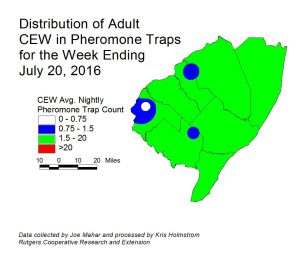
The highest nightly CEW pheromone trap catches for the previous week are as follows:
| Berlin 6 | Green Creek 3 | Springdale 2 |
| Elm 5 | East Vineland 2 | |
| Monroeville 5 | Pedricktown 2 |
For silking sweet corn, the following spray schedules are warranted.
Silking Spray Schedules*:
South – 5 days
Central – 5-6 days
North – 6-7 days
*These recommendations are based on regional catches.
Corn Leaf Rust
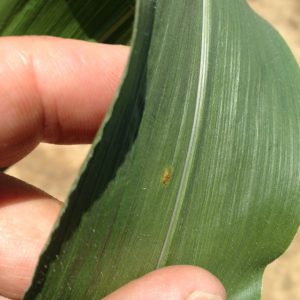 Several plantings with minor corn leaf rust infections were discovered this week in central counties. Many sweet corn varieties have good tolerance to rust, but if the pustules (see photo at left) are discovered in whorl stage plantings, fungicide applications may be necessary to limit the presence of the disease on developing ears. Heavy infestations can result in unsightly husks, or even shorter than normal ears. See the 2016 Commercial Vegetable Production Recommendations for fungicides useful against corn leaf rust.
Several plantings with minor corn leaf rust infections were discovered this week in central counties. Many sweet corn varieties have good tolerance to rust, but if the pustules (see photo at left) are discovered in whorl stage plantings, fungicide applications may be necessary to limit the presence of the disease on developing ears. Heavy infestations can result in unsightly husks, or even shorter than normal ears. See the 2016 Commercial Vegetable Production Recommendations for fungicides useful against corn leaf rust.
Brown Marmorated Stinkbug (BMSB)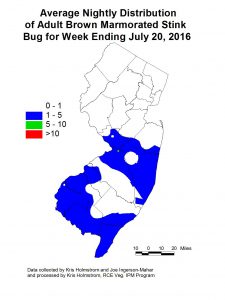
BMSB captures in central and southern NJ blacklight traps have generally remained higher than in the north over the past week. The highest activity is currently in the Burlington-Mercer County area (see BMSB map). At the present time, BMSB numbers are well below those seen in 2010-12. However, this increase will be monitored and incidents of injury from this pest will be documented. BMSB can be a pest on peppers, as well as sweet corn and beans. As yet, no individuals have been spotted in scouted peppers.
The highest nightly BMSB trap catches for the previous week are as follows:
| Woodstown 5 | Beckett 3 | Georgetown 2 |
| Crosswicks 4 | Centerton 3 | Jones Island 2 |
| Green Creek 4 | Eldora 2 | Matawan 2 |
| Springdale 4 | Farmingdale 2 | Princeton 2 |
Pumpkins and Winter Squash
These crops are now mostly in bloom stage. Cucumber beetles are less of a threat at this stage, as the plants have attained enough size to avoid developing bacterial wilt from new beetle feeding.
As scouted pumpkin and winter squash fields begin to develop fruit, we would expect to see powdery mildew (PM) develop. As yet, the most mature fields in the IPM Program are just reaching the vine-run stage and are free of powdery mildew. The action threshold for commencement of the protectant fungicide program for PM is 2 lesions per 100 older leaves. The most mature fields in the IPM Program are still approximately 2 weeks from fruit enlargement; the stage at which first PM lesions often occur.
A sentinel plot containing susceptible and resistant cucumber varieties, as well as muskmelons, watermelons, acorn and butternut squash and pumpkins is now established at the Snyder Research and Extension Farm in Hunterdon County. The purpose of this plot is to detect the presence of downy mildew (DM) in northern NJ. Any occurrence will be reported in this newsletter and will also generate an alert to all subscribers. As of July 20, no DM was detected on any vine crop in the sentinel plot. However, DM has been reported on cucumbers in southern NJ, and the mid-week showers we have just had will make conditions more favorable for disease development. For more information on the regional presence of DM as well as comprehensive, weekly forecasts, see the following website: http://cdm.ipmpipe.org/
Native brown stink bugs have been observed in a few northern NJ pepper fields this week. The appearance of this pest in peppers and tomatoes follows increased catches of all stinkbugs in recent weeks. July is the month when injury typically increases, and the presence of stink bugs in a planting is often detected by the appearance of damaged fruit rather than the discovery of actual bugs. Damage, called “cloudy spot” of often pale green on green pepper and tomato fruit (see photo at right). It is often best to approach sample sites slowly while scouting. Stink bugs will often bask in the sun near the tops of plants, but will quickly descend into the canopy when approached. Consider treating if brown sink bugs are found in more than one sample site in 10, or the presence of feeding on harvested fruit is increasing. See the 2016 Commercial Vegetable Recommendations Guide for a insecticides useful in the control of stink bugs.
Pepper weevil
One weevil was found on a field trap in the Hammonton area. As far as is known there are no infested fields.
